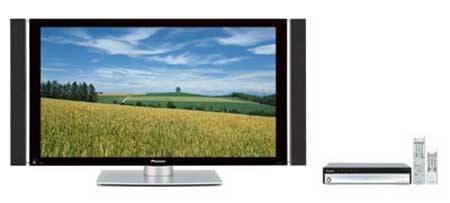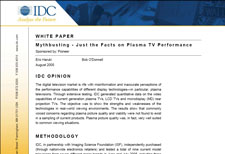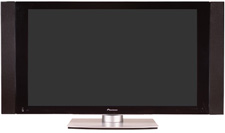Plasma TV Mythbusters

The study, commissioned by Pioneer Electronics (USA) and called "Mythbusting - Just the Facts on Plasma TV Performance", included a series of tests designed to measure picture quality "in a way that better represents what consumers really see when watching television". Pioneer's release of the study, an unusual, public-spirited, altruistic act rarely seen coming from large, multinational companies, occurred at the same time the company revealed their quartet of new plasma sets. When asked about the amazing coincidence, the Pioneer PR spokesperson said, "Oh my, look at the time! Well, we've got to go. Thanks for coming everyone. And don't forget to mention that study in all your reports."
 IDC, a "global provider of market intelligence, advisory services, and events for the information technology and telecommunications industries", coordinated the study and used a separate, independent testing laboratory - the Imaging Science Foundation (ISF) - to conduct a series of "real-world" tests of high-definition plasma, LCD, and Microdisplay rear-projection TVs. They tested off-the-shelf HDTVs purchased by ISF at local retail electronics stores. (You can just hear the joy in the voice of the salesperson after being approached by the undercover ISF TV buyer. "You want how many TVs? And you don't want a demonstration or have any questions? Ka-ching!") IDC said the goal of the tests was to "measure picture quality in a way that better represents what consumers really see when watching television." ISF measured color uniformity, viewing angles, black levels, contrast ratios, and image retention.
IDC, a "global provider of market intelligence, advisory services, and events for the information technology and telecommunications industries", coordinated the study and used a separate, independent testing laboratory - the Imaging Science Foundation (ISF) - to conduct a series of "real-world" tests of high-definition plasma, LCD, and Microdisplay rear-projection TVs. They tested off-the-shelf HDTVs purchased by ISF at local retail electronics stores. (You can just hear the joy in the voice of the salesperson after being approached by the undercover ISF TV buyer. "You want how many TVs? And you don't want a demonstration or have any questions? Ka-ching!") IDC said the goal of the tests was to "measure picture quality in a way that better represents what consumers really see when watching television." ISF measured color uniformity, viewing angles, black levels, contrast ratios, and image retention.
According to Bob O'Donnell, vice president, mobility and display technology for IDC, "What we found is that plasma provides viewers with an excellent high-definition viewing experience when it comes to color accuracy, consistency, sharpness, and image detail. Plasma performs particularly well in providing a consistent viewing experience across all viewing angles. This is important if a family or a group of friends is seated around a TV watching a movie or if during a sporting event the action moves across the screen." (You can currently download the IDC white paper from a link on Pioneer's home page.)
 All three technology types of TVs underwent a "torture" test1 in which a static video game image was displayed on the screen for 48 hours. (Three teenagers were also strapped to chairs in front of the set with video game controllers positioned just out of reach. This had nothing to do with the study itself, but it did make the researchers laugh a lot.) After the initial 48 hours of no on-screen movement, the TVs were sent a 24-hour loop of standard video content. (I think it involved Scooby-Doo cartoons, but no one at ISF would confirm that.) After untying the tortured teens, the researchers found that "the 24-hour video loop essentially 'cleaned' the screen leaving no perceptible trace of the original static image." I suppose you could say it removed that annoying static (image) cling…
All three technology types of TVs underwent a "torture" test1 in which a static video game image was displayed on the screen for 48 hours. (Three teenagers were also strapped to chairs in front of the set with video game controllers positioned just out of reach. This had nothing to do with the study itself, but it did make the researchers laugh a lot.) After the initial 48 hours of no on-screen movement, the TVs were sent a 24-hour loop of standard video content. (I think it involved Scooby-Doo cartoons, but no one at ISF would confirm that.) After untying the tortured teens, the researchers found that "the 24-hour video loop essentially 'cleaned' the screen leaving no perceptible trace of the original static image." I suppose you could say it removed that annoying static (image) cling…
Oh, yeah, what about those new plasma HDTVs? Pioneer Elite's new models, the 50-inch PRO-1130HD ($6,500) and 43-inch PRO-930HD ($5,000), are said to use Pioneer's 6th-generation glass along with what Pioneer calls its PureDrive II video processing technology. In addition to a 27 percent slimmer bezel, a TV Guide On Screen interactive program guide, and a Home Gallery PC card slot for viewing digital images stored on most major types of flash memory cards, the new Elite plasma HDTVs incorporate the capability for a certified technician to perform an advanced calibration of the display's color. Calibration technicians will squeal2 with joy when they discover a detailed gamma selection with eight steps. Pioneer expects both models to be available in September.
The less fancy Pioneer plasma HDTVs - the PDP-5060HD (50-inch) and PDP-4360HD (43-inch) - will also be available in September with an "estimated market price" of $6,000 and $4,500 respectively.
1TV torture test kits are not available through Pioneer, ISF, or IDC.
2None of the TV technicians I've known have ever squealed at anything. What they'll actually do when they run across that eight-step gamma selection is smile ever so slightly and say, "Well, it's about time." Sorry, folks, with most video techs, that's as good as it gets.



















































